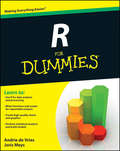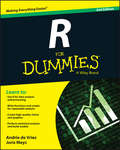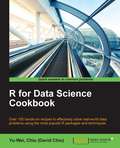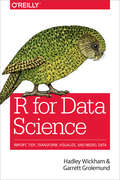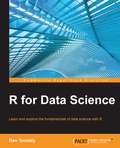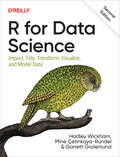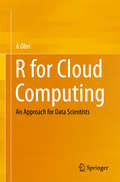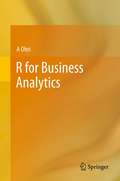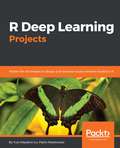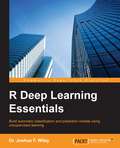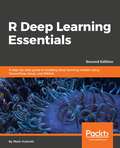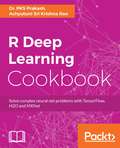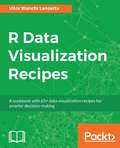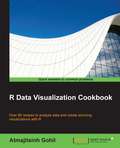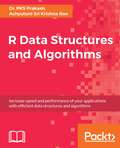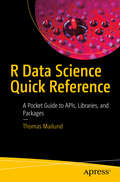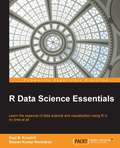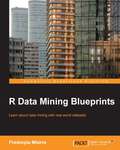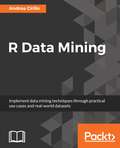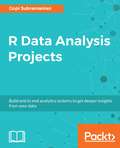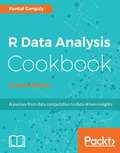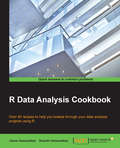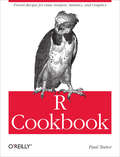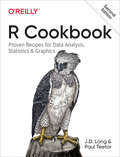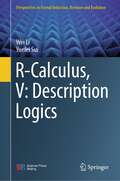- Table View
- List View
R For Dummies
by Andrie de Vries Joris MeysMaster the programming language of choice among statisticians and data analysts worldwide Coming to grips with R can be tough, even for seasoned statisticians and data analysts. Enter R For Dummies, the quick, easy way to master all the R you'll ever need. Requiring no prior programming experience and packed with practical examples, easy, step-by-step exercises, and sample code, this extremely accessible guide is the ideal introduction to R for complete beginners. It also covers many concepts that intermediate-level programmers will find extremely useful. Master your R ABCs ? get up to speed in no time with the basics, from installing and configuring R to writing simple scripts and performing simultaneous calculations on many variables Put data in its place ? get to know your way around lists, data frames, and other R data structures while learning to interact with other programs, such as Microsoft Excel Make data dance to your tune ? learn how to reshape and manipulate data, merge data sets, split and combine data, perform calculations on vectors and arrays, and much more Visualize it ? learn to use R's powerful data visualization features to create beautiful and informative graphical presentations of your data Get statistical ? find out how to do simple statistical analysis, summarize your variables, and conduct classic statistical tests, such as t-tests Expand and customize R ? get the lowdown on how to find, install, and make the most of add-on packages created by the global R community for a wide variety of purposes Open the book and find: Help downloading, installing, and configuring R Tips for getting data in and out of R Ways to use data frames and lists to organize data How to manipulate and process data Advice on fitting regression models and ANOVA Helpful hints for working with graphics How to code in R What R mailing lists and forums can do for you
R For Dummies
by Joris Meys Andrie De VriesMaster the programming language of choice among statisticians and data analysts worldwideComing to grips with R can be tough, even for seasoned statisticians and data analysts. Enter R For Dummies, the quick, easy way to master all the R you'll ever need. Requiring no prior programming experience and packed with practical examples, easy, step-by-step exercises, and sample code, this extremely accessible guide is the ideal introduction to R for complete beginners. It also covers many concepts that intermediate-level programmers will find extremely useful.Master your R ABCs ? get up to speed in no time with the basics, from installing and configuring R to writing simple scripts and performing simultaneous calculations on many variables Put data in its place ? get to know your way around lists, data frames, and other R data structures while learning to interact with other programs, such as Microsoft Excel Make data dance to your tune ? learn how to reshape and manipulate data, merge data sets, split and combine data, perform calculations on vectors and arrays, and much more Visualize it ? learn to use R's powerful data visualization features to create beautiful and informative graphical presentations of your data Get statistical ? find out how to do simple statistical analysis, summarize your variables, and conduct classic statistical tests, such as t-tests Expand and customize R ? get the lowdown on how to find, install, and make the most of add-on packages created by the global R community for a wide variety of purposesOpen the book and find:Help downloading, installing, and configuring RTips for getting data in and out of RWays to use data frames and lists to organize dataHow to manipulate and process dataAdvice on fitting regression models and ANOVAHelpful hints for working with graphicsHow to code in RWhat R mailing lists and forums can do for you
R for Data Science Cookbook
by Chiu Yu-WeiOver 100 hands-on recipes to effectively solve real-world data problems using the most popular R packages and techniques About This Book * Gain insight into how data scientists collect, process, analyze, and visualize data using some of the most popular R packages * Understand how to apply useful data analysis techniques in R for real-world applications * An easy-to-follow guide to make the life of data scientist easier with the problems faced while performing data analysis Who This Book Is For This book is for those who are already familiar with the basic operation of R, but want to learn how to efficiently and effectively analyze real-world data problems using practical R packages. What You Will Learn * Get to know the functional characteristics of R language * Extract, transform, and load data from heterogeneous sources * Understand how easily R can confront probability and statistics problems * Get simple R instructions to quickly organize and manipulate large datasets * Create professional data visualizations and interactive reports * Predict user purchase behavior by adopting a classification approach * Implement data mining techniques to discover items that are frequently purchased together * Group similar text documents by using various clustering methods In Detail This cookbook offers a range of data analysis samples in simple and straightforward R code, providing step-by-step resources and time-saving methods to help you solve data problems efficiently. The first section deals with how to create R functions to avoid the unnecessary duplication of code. You will learn how to prepare, process, and perform sophisticated ETL for heterogeneous data sources with R packages. An example of data manipulation is provided, illustrating how to use the "dplyr" and "data.table" packages to efficiently process larger data structures. We also focus on "ggplot2" and show you how to create advanced figures for data exploration. In addition, you will learn how to build an interactive report using the "ggvis" package. Later chapters offer insight into time series analysis on financial data, while there is detailed information on the hot topic of machine learning, including data classification, regression, clustering, association rule mining, and dimension reduction. By the end of this book, you will understand how to resolve issues and will be able to comfortably offer solutions to problems encountered while performing data analysis. Style and approach This easy-to-follow guide is full of hands-on examples of data analysis with R. Each topic is fully explained beginning with the core concept, followed by step-by-step practical examples, and concluding with detailed explanations of each concept used.
R for Data Science: Import, Tidy, Transform, Visualize, and Model Data
by Garrett Grolemund Hadley WickhamLearn how to use R to turn raw data into insight, knowledge, and understanding. This book introduces you to R, RStudio, and the tidyverse, a collection of R packages designed to work together to make data science fast, fluent, and fun. Suitable for readers with no previous programming experience, R for Data Science is designed to get you doing data science as quickly as possible.Authors Hadley Wickham and Garrett Grolemund guide you through the steps of importing, wrangling, exploring, and modeling your data and communicating the results. You’ll get a complete, big-picture understanding of the data science cycle, along with basic tools you need to manage the details. Each section of the book is paired with exercises to help you practice what you’ve learned along the way.You’ll learn how to:Wrangle—transform your datasets into a form convenient for analysisProgram—learn powerful R tools for solving data problems with greater clarity and easeExplore—examine your data, generate hypotheses, and quickly test themModel—provide a low-dimensional summary that captures true "signals" in your datasetCommunicate—learn R Markdown for integrating prose, code, and results
R for Data Science
by Dan ToomeyIf you are a data analyst who has a firm grip on some advanced data analysis techniques and wants to learn how to leverage the features of R, this is the book for you. You should have some basic knowledge of the R language and should know about some data science topics.
R for Data Science
by Hadley Wickham Mine Çetinkaya-Rundel Garrett GrolemundUse R to turn data into insight, knowledge, and understanding. With this practical book, aspiring data scientists will learn how to do data science with R and RStudio, along with the tidyverse—a collection of R packages designed to work together to make data science fast, fluent, and fun. Even if you have no programming experience, this updated edition will have you doing data science quickly.You'll learn how to import, transform, and visualize your data and communicate the results. And you'll get a complete, big-picture understanding of the data science cycle and the basic tools you need to manage the details. Updated for the latest tidyverse features and best practices, new chapters show you how to get data from spreadsheets, databases, and websites. Exercises help you practice what you've learned along the way.You'll understand how to:Visualize: Create plots for data exploration and communication of resultsTransform: Discover variable types and the tools to work with themImport: Get data into R and in a form convenient for analysisProgram: Learn R tools for solving data problems with greater clarity and easeCommunicate: Integrate prose, code, and results with Quarto
R for Cloud Computing
by A OhriR for Cloud Computing looks at some of the tasks performed by business analysts on the desktop (PC era) and helps the user navigate the wealth of information in R and its 4000 packages as well as transition the same analytics using the cloud. With this information the reader can select both cloud vendors and the sometimes confusing cloud ecosystem as well as the R packages that can help process the analytical tasks with minimum effort, cost and maximum usefulness and customization. The use of Graphical User Interfaces (GUI) and Step by Step screenshot tutorials is emphasized in this book to lessen the famous learning curve in learning R and some of the needless confusion created in cloud computing that hinders its widespread adoption. This will help you kick-start analytics on the cloud including chapters on both cloud computing, R, common tasks performed in analytics including the current focus and scrutiny of Big Data Analytics, setting up and navigating cloud providers. Readers are exposed to a breadth of cloud computing choices and analytics topics without being buried in needless depth. The included references and links allow the reader to pursue business analytics on the cloud easily. It is aimed at practical analytics and is easy to transition from existing analytical set up to the cloud on an open source system based primarily on R. This book is aimed at industry practitioners with basic programming skills and students who want to enter analytics as a profession. Note the scope of the book is neither statistical theory nor graduate level research for statistics, but rather it is for business analytics practitioners. It will also help researchers and academics but at a practical rather than conceptual level. The R statistical software is the fastest growing analytics platform in the world, and is established in both academia and corporations for robustness, reliability and accuracy. The cloud computing paradigm is firmly established as the next generation of computing from microprocessors to desktop PCs to cloud.
R for Business Analytics
by A OhriR for Business Analytics looks at some of the most common tasks performed by business analysts and helps the user navigate the wealth of information in R and its 4000 packages. With this information the reader can select the packages that can help process the analytical tasks with minimum effort and maximum usefulness. The use of Graphical User Interfaces (GUI) is emphasized in this book to further cut down and bend the famous learning curve in learning R. This book is aimed to help you kick-start with analytics including chapters on data visualization, code examples on web analytics and social media analytics, clustering, regression models, text mining, data mining models and forecasting. The book tries to expose the reader to a breadth of business analytics topics without burying the user in needless depth. The included references and links allow the reader to pursue business analytics topics. This book is aimed at business analysts with basic programming skills for using R for Business Analytics. Note the scope of the book is neither statistical theory nor graduate level research for statistics, but rather it is for business analytics practitioners. Business analytics (BA) refers to the field of exploration and investigation of data generated by businesses. Business Intelligence (BI) is the seamless dissemination of information through the organization, which primarily involves business metrics both past and current for the use of decision support in businesses. Data Mining (DM) is the process of discovering new patterns from large data using algorithms and statistical methods. To differentiate between the three, BI is mostly current reports, BA is models to predict and strategize and DM matches patterns in big data. The R statistical software is the fastest growing analytics platform in the world, and is established in both academia and corporations for robustness, reliability and accuracy. The book utilizes Albert Einstein's famous remarks on making things as simple as possible, but no simpler. This book will blow the last remaining doubts in your mind about using R in your business environment. Even non-technical users will enjoy the easy-to-use examples. The interviews with creators and corporate users of R make the book very readable. The author firmly believes Isaac Asimov was a better writer in spreading science than any textbook or journal author.
R Deep Learning Projects: Master the techniques to design and develop neural network models in R
by Yuxi Hayden Liu Pablo Maldonado5 real-world projects to help you master deep learning concepts Key Features Master the different deep learning paradigms and build real-world projects related to text generation, sentiment analysis, fraud detection, and more Get to grips with R's impressive range of Deep Learning libraries and frameworks such as deepnet, MXNetR, Tensorflow, H2O, Keras, and text2vec Practical projects that show you how to implement different neural networks with helpful tips, tricks, and best practices Book Description R is a popular programming language used by statisticians and mathematicians for statistical analysis, and is popularly used for deep learning. Deep Learning, as we all know, is one of the trending topics today, and is finding practical applications in a lot of domains. This book demonstrates end-to-end implementations of five real-world projects on popular topics in deep learning such as handwritten digit recognition, traffic light detection, fraud detection, text generation, and sentiment analysis. You'll learn how to train effective neural networks in R—including convolutional neural networks, recurrent neural networks, and LSTMs—and apply them in practical scenarios. The book also highlights how neural networks can be trained using GPU capabilities. You will use popular R libraries and packages—such as MXNetR, H2O, deepnet, and more—to implement the projects. By the end of this book, you will have a better understanding of deep learning concepts and techniques and how to use them in a practical setting. What you will learn - Instrument Deep Learning models with packages such as deepnet, MXNetR, Tensorflow, H2O, Keras, and text2vec - Apply neural networks to perform handwritten digit recognition using MXNet - Get the knack of CNN models, Neural Network API, Keras, and TensorFlow for traffic sign classification -Implement credit card fraud detection with Autoencoders -Master reconstructing images using variational autoencoders - Wade through sentiment analysis from movie reviews - Run from past to future and vice versa with bidirectional Long Short-Term Memory (LSTM) networks - Understand the applications of Autoencoder Neural Networks in clustering and dimensionality reductionWho this book is for Machine learning professionals and data scientists looking to master deep learning by implementing practical projects in R will find this book a useful resource. A knowledge of R programming and the basic concepts of deep learning is required to get the best out of this book.
R Deep Learning Essentials
by Dr Joshua WileyThis book caters to aspiring data scientists who are well versed with machine learning concepts with R and are looking to explore the deep learning paradigm using the packages available in R. You should have a fundamental understanding of the R language and be comfortable with statistical algorithms and machine learning techniques, but you do not need to be well versed with deep learning concepts.
R Deep Learning Essentials: A step-by-step guide to building deep learning models using TensorFlow, Keras, and MXNet, 2nd Edition
by Joshua F. Wiley Mark HodnettImplement neural network models in R 3.5 using TensorFlow, Keras, and MXNetKey FeaturesUse R 3.5 for building deep learning models for computer vision and textApply deep learning techniques in cloud for large-scale processingBuild, train, and optimize neural network models on a range of datasetsBook DescriptionDeep learning is a powerful subset of machine learning that is very successful in domains such as computer vision and natural language processing (NLP). This second edition of R Deep Learning Essentials will open the gates for you to enter the world of neural networks by building powerful deep learning models using the R ecosystem.This book will introduce you to the basic principles of deep learning and teach you to build a neural network model from scratch. As you make your way through the book, you will explore deep learning libraries, such as Keras, MXNet, and TensorFlow, and create interesting deep learning models for a variety of tasks and problems, including structured data, computer vision, text data, anomaly detection, and recommendation systems. You’ll cover advanced topics, such as generative adversarial networks (GANs), transfer learning, and large-scale deep learning in the cloud. In the concluding chapters, you will learn about the theoretical concepts of deep learning projects, such as model optimization, overfitting, and data augmentation, together with other advanced topics.By the end of this book, you will be fully prepared and able to implement deep learning concepts in your research work or projects.What you will learnBuild shallow neural network prediction modelsPrevent models from overfitting the data to improve generalizabilityExplore techniques for finding the best hyperparameters for deep learning modelsCreate NLP models using Keras and TensorFlow in RUse deep learning for computer vision tasksImplement deep learning tasks, such as NLP, recommendation systems, and autoencodersWho this book is forThis second edition of R Deep Learning Essentials is for aspiring data scientists, data analysts, machine learning developers, and deep learning enthusiasts who are well versed in machine learning concepts and are looking to explore the deep learning paradigm using R. Fundamental understanding of the R language is necessary to get the most out of this book.
R Deep Learning Cookbook
by Achyutuni Sri Rao Dr Pks PrakashPowerful, independent recipes to build deep learning models in different application areas using R libraries About This Book • Master intricacies of R deep learning packages such as mxnet & tensorflow • Learn application on deep learning in different domains using practical examples from text, image and speech • Guide to set-up deep learning models using CPU and GPU Who This Book Is For Data science professionals or analysts who have performed machine learning tasks and now want to explore deep learning and want a quick reference that could address the pain points while implementing deep learning. Those who wish to have an edge over other deep learning professionals will find this book quite useful. What You Will Learn • Build deep learning models in different application areas using TensorFlow, H2O, and MXnet. • Analyzing a Deep boltzmann machine • Setting up and Analysing Deep belief networks • Building supervised model using various machine learning algorithms • Set up variants of basic convolution function • Represent data using Autoencoders. • Explore generative models available in Deep Learning. • Discover sequence modeling using Recurrent nets • Learn fundamentals of Reinforcement Leaning • Learn the steps involved in applying Deep Learning in text mining • Explore application of deep learning in signal processing • Utilize Transfer learning for utilizing pre-trained model • Train a deep learning model on a GPU In Detail Deep Learning is the next big thing. It is a part of machine learning. It's favorable results in applications with huge and complex data is remarkable. Simultaneously, R programming language is very popular amongst the data miners and statisticians. This book will help you to get through the problems that you face during the execution of different tasks and Understand hacks in deep learning, neural networks, and advanced machine learning techniques. It will also take you through complex deep learning algorithms and various deep learning packages and libraries in R. It will be starting with different packages in Deep Learning to neural networks and structures. You will also encounter the applications in text mining and processing along with a comparison between CPU and GPU performance. By the end of the book, you will have a logical understanding of Deep learning and different deep learning packages to have the most appropriate solutions for your problems. Style and approach Collection of hands-on recipes that would act as your all-time reference for your deep learning needs
R Data Visualization Recipes
by Vitor Bianchi LanzettaTranslate your data into info-graphics using popular packages in R About This Book • Use R's popular packages—such as ggplot2, ggvis, ggforce, and more—to create custom, interactive visualization solutions. • Create, design, and build interactive dashboards using Shiny • A highly practical guide to help you get to grips with the basics of data visualization techniques, and how you can implement them using R Who This Book Is For If you are looking to create custom data visualization solutions using the R programming language and are stuck somewhere in the process, this book will come to your rescue. Prior exposure to packages such as ggplot2 would be useful but not necessary. However, some R programming knowledge is required. What You Will Learn • Get to know various data visualization libraries available in R to represent data • Generate elegant codes to craft graphics using ggplot2, ggvis and plotly • Add elements, text, animation, and colors to your plot to make sense of data • Deepen your knowledge by adding bar-charts, scatterplots, and time series plots using ggplot2 • Build interactive dashboards using Shiny. • Color specific map regions based on the values of a variable in your data frame • Create high-quality journal-publishable scatterplots • Create and design various three-dimensional and multivariate plots In Detail R is an open source language for data analysis and graphics that allows users to load various packages for effective and better data interpretation. Its popularity has soared in recent years because of its powerful capabilities when it comes to turning different kinds of data into intuitive visualization solutions. This book is an update to our earlier R data visualization cookbook with 100 percent fresh content and covering all the cutting edge R data visualization tools. This book is packed with practical recipes, designed to provide you with all the guidance needed to get to grips with data visualization using R. It starts off with the basics of ggplot2, ggvis, and plotly visualization packages, along with an introduction to creating maps and customizing them, before progressively taking you through various ggplot2 extensions, such as ggforce, ggrepel, and gganimate. Using real-world datasets, you will analyze and visualize your data as histograms, bar graphs, and scatterplots, and customize your plots with various themes and coloring options. The book also covers advanced visualization aspects such as creating interactive dashboards using Shiny By the end of the book, you will be equipped with key techniques to create impressive data visualizations with professional efficiency and precision. Style and approach This book is packed with practical recipes, designed to provide you with all the guidance needed to get to grips with data visualization with R. You will learn to leverage the power of R and ggplot2 to create highly customizable data visualizations of varying complexities. The readers will then learn how to create, design, and build interactive dashboards using Shiny.
R Data Visualization Cookbook
by Atmajitsinh GohilIf you are a data journalist, academician, student or freelance designer who wants to learn about data visualization, this book is for you. Basic knowledge of R programming is expected.
R Data Structures and Algorithms
by Dr Pks Prakash Achyutuni Sri RaoIncrease speed and performance of your applications with efficient data structures and algorithms About This Book * See how to use data structures such as arrays, stacks, trees, lists, and graphs through real-world examples * Find out about important and advanced data structures such as searching and sorting algorithms * Understand important concepts such as big-o notation, dynamic programming, and functional data structured Who This Book Is For This book is for R developers who want to use data structures efficiently. Basic knowledge of R is expected. What You Will Learn * Understand the rationality behind data structures and algorithms * Understand computation evaluation of a program featuring asymptotic and empirical algorithm analysis * Get to know the fundamentals of arrays and linked-based data structures * Analyze types of sorting algorithms * Search algorithms along with hashing * Understand linear and tree-based indexing * Be able to implement a graph including topological sort, shortest path problem, and Prim's algorithm * Understand dynamic programming (Knapsack) and randomized algorithms In Detail In this book, we cover not only classical data structures, but also functional data structures. We begin by answering the fundamental question: why data structures? We then move on to cover the relationship between data structures and algorithms, followed by an analysis and evaluation of algorithms. We introduce the fundamentals of data structures, such as lists, stacks, queues, and dictionaries, using real-world examples. We also cover topics such as indexing, sorting, and searching in depth. Later on, you will be exposed to advanced topics such as graph data structures, dynamic programming, and randomized algorithms. You will come to appreciate the intricacies of high performance and scalable programming using R. We also cover special R data structures such as vectors, data frames, and atomic vectors. With this easy-to-read book, you will be able to understand the power of linked lists, double linked lists, and circular linked lists. We will also explore the application of binary search and will go in depth into sorting algorithms such as bubble sort, selection sort, insertion sort, and merge sort. Style and approach This easy-to-read book with its fast-paced nature will improve the productivity of an R programmer and improve the performance of R applications. It is packed with real-world examples.
R Data Science Quick Reference: A Pocket Guide to APIs, Libraries, and Packages
by Thomas MailundIn this handy, practical book you will cover each concept concisely, with many illustrative examples. You'll be introduced to several R data science packages, with examples of how to use each of them. In this book, you’ll learn about the following APIs and packages that deal specifically with data science applications: readr, dibble, forecasts, lubridate, stringr, tidyr, magnittr, dplyr, purrr, ggplot2, modelr, and more.After using this handy quick reference guide, you'll have the code, APIs, and insights to write data science-based applications in the R programming language. You'll also be able to carry out data analysis. What You Will LearnImport data with readrWork with categories using forcats, time and dates with lubridate, and strings with stringrFormat data using tidyr and then transform that data using magrittr and dplyrWrite functions with R for data science, data mining, and analytics-based applicationsVisualize data with ggplot2 and fit data to models using modelrWho This Book Is ForProgrammers new to R's data science, data mining, and analytics packages. Some prior coding experience with R in general is recommended.
R Data Science Essentials
by Raja B. Koushik Sharan Kumar RavindranLearn the essence of data science and visualization using R in no time at allAbout This BookBecome a pro at making stunning visualizations and dashboards quickly and without hassleFor better decision making in business, apply the R programming language with the help of useful statistical techniques.From seasoned authors comes a book that offers you a plethora of fast-paced techniques to detect and analyze data patternsWho This Book Is ForIf you are an aspiring data scientist or analyst who has a basic understanding of data science and has basic hands-on experience in R or any other analytics tool, then R Data Science Essentials is the book for you.What You Will LearnPerform data preprocessing and basic operations on dataImplement visual and non-visual implementation data exploration techniquesMine patterns from data using affinity and sequential analysisUse different clustering algorithms and visualize themImplement logistic and linear regression and find out how to evaluate and improve the performance of an algorithmExtract patterns through visualization and build a forecasting algorithmBuild a recommendation engine using different collaborative filtering algorithmsMake a stunning visualization and dashboard using ggplot and R shinyIn DetailWith organizations increasingly embedding data science across their enterprise and with management becoming more data-driven it is an urgent requirement for analysts and managers to understand the key concept of data science. The data science concepts discussed in this book will help you make key decisions and solve the complex problems you will inevitably face in this new world.R Data Science Essentials will introduce you to various important concepts in the field of data science using R. We start by reading data from multiple sources, then move on to processing the data, extracting hidden patterns, building predictive and forecasting models, building a recommendation engine, and communicating to the user through stunning visualizations and dashboards.By the end of this book, you will have an understanding of some very important techniques in data science, be able to implement them using R, understand and interpret the outcomes, and know how they helps businesses make a decision.Style and approachThis easy-to-follow guide contains hands-on examples of the concepts of data science using R.
R Data Mining Blueprints
by Pradeepta MishraLearn about data mining with real-world datasets About This Book * Diverse real-world datasets to teach data mining techniques * Practical and focused on real-world data mining cases, this book covers concepts such as spatial data mining, text mining, social media mining, and web mining * Real-world case studies illustrate various data mining techniques, taking you from novice to intermediate Who This Book Is For Data analysts from beginner to intermediate level who need a step-by-step helping hand in developing complex data mining projects are the ideal audience for this book. They should have prior knowledge of basic statistics and little bit of programming language experience in any tool or platform. What You Will Learn * Make use of statistics and programming to learn data mining concepts and its applications * Use R Programming to apply statistical models on data * Create predictive models to be applied for performing classification, prediction and recommendation * Use of various libraries available on R CRAN (comprehensive R archives network) in data mining * Apply data management steps in handling large datasets * Learn various data visualization libraries available in R for representing data * Implement various dimension reduction techniques to handle large datasets * Acquire knowledge about neural network concept drawn from computer science and its applications in data mining In Detail The R language is a powerful open source functional programming language. At its core, R is a statistical programming language that provides impressive tools for data mining and analysis. It enables you to create high-level graphics and offers an interface to other languages. This means R is best suited to produce data and visual analytics through customization scripts and commands, instead of the typical statistical tools that provide tick boxes and drop-down menus for users. This book explores data mining techniques and shows you how to apply different mining concepts to various statistical and data applications in a wide range of fields. We will teach you about R and its application to data mining, and give you relevant and useful information you can use to develop and improve your applications. It will help you complete complex data mining cases and guide you through handling issues you might encounter during projects. Style and approach This fast-paced guide will help you solve predictive modeling problems using the most popular data mining algorithms through simple, practical cases.
R Data Mining
by Andrea CirilloMine valuable insights from your data using popular tools and techniques in R About This Book • Understand the basics of data mining and why R is a perfect tool for it. • Manipulate your data using popular R packages such as ggplot2, dplyr, and so on to gather valuable business insights from it. • Apply effective data mining models to perform regression and classification tasks. Who This Book Is For If you are a budding data scientist, or a data analyst with a basic knowledge of R, and want to get into the intricacies of data mining in a practical manner, this is the book for you. No previous experience of data mining is required. What You Will Learn • Master relevant packages such as dplyr, ggplot2 and so on for data mining • Learn how to effectively organize a data mining project through the CRISP-DM methodology • Implement data cleaning and validation tasks to get your data ready for data mining activities • Execute Exploratory Data Analysis both the numerical and the graphical way • Develop simple and multiple regression models along with logistic regression • Apply basic ensemble learning techniques to join together results from different data mining models • Perform text mining analysis from unstructured pdf files and textual data • Produce reports to effectively communicate objectives, methods, and insights of your analyses In Detail R is widely used to leverage data mining techniques across many different industries, including finance, medicine, scientific research, and more. This book will empower you to produce and present impressive analyses from data, by selecting and implementing the appropriate data mining techniques in R. It will let you gain these powerful skills while immersing in a one of a kind data mining crime case, where you will be requested to help resolving a real fraud case affecting a commercial company, by the mean of both basic and advanced data mining techniques. While moving along the plot of the story you will effectively learn and practice on real data the various R packages commonly employed for this kind of tasks. You will also get the chance of apply some of the most popular and effective data mining models and algos, from the basic multiple linear regression to the most advanced Support Vector Machines. Unlike other data mining learning instruments, this book will effectively expose you the theory behind these models, their relevant assumptions and when they can be applied to the data you are facing. By the end of the book you will hold a new and powerful toolbox of instruments, exactly knowing when and how to employ each of them to solve your data mining problems and get the most out of your data. Finally, to let you maximize the exposure to the concepts described and the learning process, the book comes packed with a reproducible bundle of commented R scripts and a practical set of data mining models cheat sheets. Style and approach This book takes a practical, step-by-step approach to explain the concepts of data mining. Practical use-cases involving real-world datasets are used throughout the book to clearly explain theoretical concepts.
R Data Analysis Projects
by Gopi SubramanianGet valuable insights from your data by building data analysis systems from scratch with R. About This Book • A handy guide to take your understanding of data analysis with R to the next level • Real-world projects that focus on problems in finance, network analysis, social media, and more • From data manipulation to analysis to visualization in R, this book will teach you everything you need to know about building end-to-end data analysis pipelines using R Who This Book Is For If you are looking for a book that takes you all the way through the practical application of advanced and effective analytics methodologies in R, then this is the book for you. A fundamental understanding of R and the basic concepts of data analysis is all you need to get started with this book. What You Will Learn • Build end-to-end predictive analytics systems in R • Build an experimental design to gather your own data and conduct analysis • Build a recommender system from scratch using different approaches • Use and leverage RShiny to build reactive programming applications • Build systems for varied domains including market research, network analysis, social media analysis, and more • Explore various R Packages such as RShiny, ggplot, recommenderlab, dplyr, and find out how to use them effectively • Communicate modeling results using Shiny Dashboards • Perform multi-variate time-series analysis prediction, supplemented with sensitivity analysis and risk modeling In Detail R offers a large variety of packages and libraries for fast and accurate data analysis and visualization. As a result, it's one of the most popularly used languages by data scientists and analysts, or anyone who wants to perform data analysis. This book will demonstrate how you can put to use your existing knowledge of data analysis in R to build highly efficient, end-to-end data analysis pipelines without any hassle. You'll start by building a content-based recommendation system, followed by building a project on sentiment analysis with tweets. You'll implement time-series modeling for anomaly detection, and understand cluster analysis of streaming data. You'll work through projects on performing efficient market data research, building recommendation systems, and analyzing networks accurately, all provided with easy to follow codes. With the help of these real-world projects, you'll get a better understanding of the challenges faced when building data analysis pipelines, and see how you can overcome them without compromising on the efficiency or accuracy of your systems. The book covers some popularly used R packages such as dplyr, ggplot2, RShiny, and others, and includes tips on using them effectively. By the end of this book, you'll have a better understanding of data analysis with R, and be able to put your knowledge to practical use without any hassle. Style and approach This book takes a unique, learn-as-you-do approach, as you build on your understanding of data analysis progressively with each project. This book is designed in a way that implementing each project will empower you with a unique skill set, and enable you to implement the next project more confidently.
R Data Analysis Cookbook - Second Edition
by Kuntal GangulyOver 80 recipes to help you breeze through your data analysis projects using R About This Book • Analyse your data using the popular R packages like ggplot2 with ready-to-use and customizable recipes • Find meaningful insights from your data and generate dynamic reports • A practical guide to help you put your data analysis skills in R to practical use Who This Book Is For This book is for data scientists, analysts and even enthusiasts who want to learn and implement the various data analysis techniques using R in a practical way. Those looking for quick, handy solutions to common tasks and challenges in data analysis will find this book to be very useful. Basic knowledge of statistics and R programming is assumed. What You Will Learn • Acquire, format and visualize your data using R • Using R to perform an Exploratory data analysis • Introduction to machine learning algorithms such as classification and regression • Get started with social network analysis • Generate dynamic reporting with Shiny • Get started with geospatial analysis • Handling large data with R using Spark and MongoDB • Build Recommendation system- Collaborative Filtering, Content based and Hybrid • Learn real world dataset examples- Fraud Detection and Image Recognition In Detail Data analytics with R has emerged as a very important focus for organizations of all kinds. R enables even those with only an intuitive grasp of the underlying concepts, without a deep mathematical background, to unleash powerful and detailed examinations of their data. This book will show you how you can put your data analysis skills in R to practical use, with recipes catering to the basic as well as advanced data analysis tasks. Right from acquiring your data and preparing it for analysis to the more complex data analysis techniques, the book will show you how you can implement each technique in the best possible manner. You will also visualize your data using the popular R packages like ggplot2 and gain hidden insights from it. Starting with implementing the basic data analysis concepts like handling your data to creating basic plots, you will master the more advanced data analysis techniques like performing cluster analysis, and generating effective analysis reports and visualizations. Throughout the book, you will get to know the common problems and obstacles you might encounter while implementing each of the data analysis techniques in R, with ways to overcoming them in the easiest possible way. By the end of this book, you will have all the knowledge you need to become an expert in data analysis with R, and put your skills to test in real-world scenarios. Style and Approach • Hands-on recipes to walk through data science challenges using R • Your one-stop solution for common and not-so-common pain points while performing real-world problems to execute a series of tasks. • Addressing your common and not-so-common pain points, this is a book that you must have on the shelf
R Data Analysis Cookbook
by Viswa Viswanathan Shanthi ViswanathanThis book is ideal for those who are already exposed to R, but have not yet used it extensively for data analytics and are seeking to get up and running quickly for analytics tasks. This book will help people who aspire to enhance their skills in any of the following ways: * perform advanced analyses and create informative and professional charts * become proficient in acquiring data from many sources * apply supervised and unsupervised data mining techniques * use R's features to present analyses professionally
R Cookbook: Proven Recipes for Data Analysis, Statistics, and Graphics (Cookbook Ser.)
by Paul TeetorWith more than 200 practical recipes, this book helps you perform data analysis with R quickly and efficiently. The R language provides everything you need to do statistical work, but its structure can be difficult to master. This collection of concise, task-oriented recipes makes you productive with R immediately, with solutions ranging from basic tasks to input and output, general statistics, graphics, and linear regression. Each recipe addresses a specific problem, with a discussion that explains the solution and offers insight into how it works. If you're a beginner, R Cookbook will help get you started. If you're an experienced data programmer, it will jog your memory and expand your horizons. You'll get the job done faster and learn more about R in the process. Create vectors, handle variables, and perform other basic functions Input and output data Tackle data structures such as matrices, lists, factors, and data frames Work with probability, probability distributions, and random variables Calculate statistics and confidence intervals, and perform statistical tests Create a variety of graphic displays Build statistical models with linear regressions and analysis of variance (ANOVA) Explore advanced statistical techniques, such as finding clusters in your data "Wonderfully readable, R Cookbook serves not only as a solutions manual of sorts, but as a truly enjoyable way to explore the R language--one practical example at a time." --Jeffrey Ryan, software consultant and R package author
R Cookbook: Proven Recipes for Data Analysis, Statistics, and Graphics (Cookbook Ser.)
by Paul Teetor Jd LongWith more than 275 practical recipes, this expanded edition helps you perform data analysis with R quickly and efficiently. The R language provides everything you need to do statistical work, but its structure can be difficult to master. These task-oriented recipes make you productive with R immediately. Solutions range from basic tasks to input and output, general statistics, graphics, and linear regression.Each recipe addresses a specific problem and includes a discussion that explains the solution and provides insight into how it works. If you’re a beginner, R Cookbook will help get you started. If you’re an intermediate user, this book will jog your memory and expand your horizons. You’ll get the job done faster and learn more about R in the process. Create vectors, handle variables, and perform other basic functions; Simplify data input and output; Tackle data structures such as matrices, lists, factors, and data frames; Work with probability, probability distributions, and random variables; Calculate statistics and confidence intervals and perform statistical tests; Create a variety of graphic displays; Build statistical models with linear regressions and analysis of variance (ANOVA). Explore advanced statistical techniques, such as finding clusters in your data.
R-Calculus, V: Description Logics (Perspectives in Formal Induction, Revision and Evolution)
by Wei Li Yuefei SuiThis book series consists of two parts, decidable description logics and undecidable description logics. It gives the R-calculi for description logics. This book offers a rich blend of theory and practice. It is suitable for students, researchers and practitioners in the field of logic.
